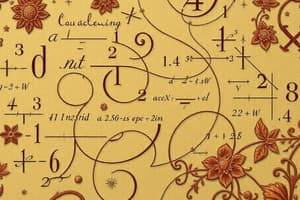Podcast
Questions and Answers
What does 'completing the square' refer to?
What does 'completing the square' refer to?
- A technique for factoring polynomial expressions
- A method of solving linear equations
- A way to find the roots of a cubic equation
- A process to rewrite a quadratic expression or equation to include a perfect square (correct)
What is an irrational number?
What is an irrational number?
Irrational numbers are numbers that cannot be written as a fraction with an integer numerator and denominator.
Define a perfect square.
Define a perfect square.
A perfect square is an expression that can be represented as something multiplied by itself.
What does the plus/minus symbol (±) represent?
What does the plus/minus symbol (±) represent?
What is the quadratic formula?
What is the quadratic formula?
What is a rational number?
What is a rational number?
What is the square root of a number?
What is the square root of a number?
Explain the zero-product property.
Explain the zero-product property.
What are the zeros of a function?
What are the zeros of a function?
Flashcards are hidden until you start studying
Study Notes
Quadratic Equations Study Notes
-
Completing the Square: Technique used to rewrite a quadratic into a form that includes a perfect square, facilitating easier solutions and graphing.
-
Irrational Numbers: Numbers that cannot be expressed as a fraction ( \frac{a}{b} ) where ( a ) and ( b ) are integers; examples include ( \sqrt{2} ) and ( \pi ).
-
Perfect Square: An expression like ( x^2 ) that can be expressed as ( (x)^2 ), indicating multiplication of a number by itself.
-
Plus/Minus Symbol (±): Represents both the positive and negative values of a number or indicates two possible solutions in equations.
-
Quadratic Formula: Formula ( x = \frac{-b \pm \sqrt{b^2 - 4ac}}{2a} ) used to find solutions for the quadratic equation ( ax^2 + bx + c = 0 ), applicable where ( a \neq 0 ).
-
Rational Numbers: Numbers that can be represented as a fraction, with both numerator and denominator being integers; for instance, ( \frac{1}{2} ) and ( 3 ).
-
Square Root: The positive value that, when multiplied by itself, equals the original number ( n ); also denotes the length of the sides of a square with area ( n ).
-
Zero-Product Property: States that if the product of multiple factors equals zero, at least one factor must be zero, simplifying solving quadratic equations.
-
Zeros of a Function: The ( x )-coordinates where the function ( f(x) = 0 ); these points are critical for graphing and analyzing the behavior of the function.
Studying That Suits You
Use AI to generate personalized quizzes and flashcards to suit your learning preferences.




